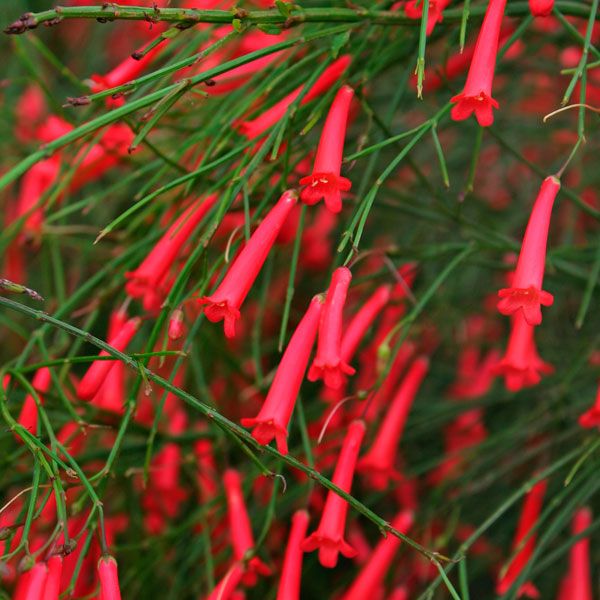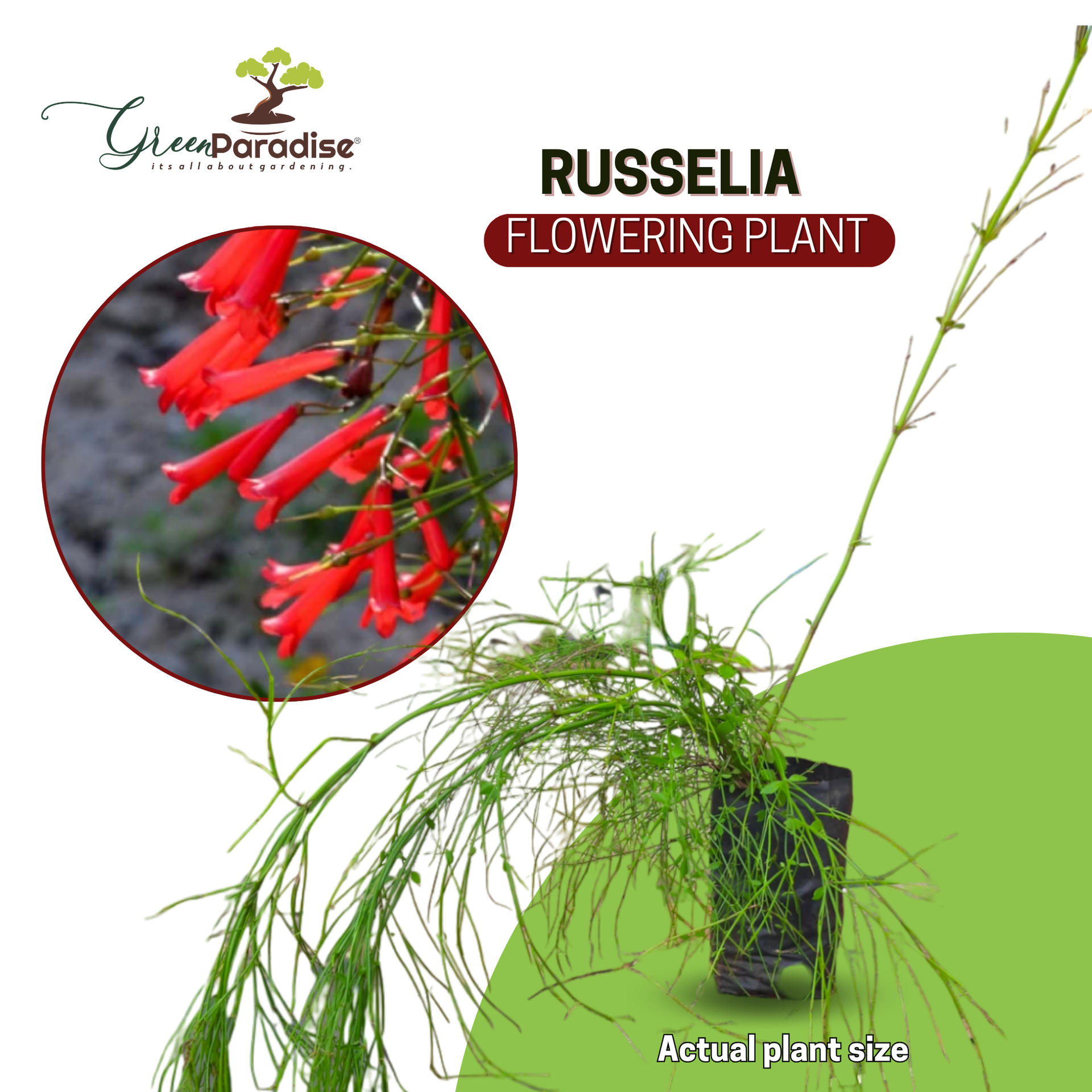



Exploring the Allure of the Green Paradise Russelia Plant: A Delight in Gardens
About Russelia Plant
In the world of botanical wonders, the Russelia plant stands as a captivating testament to nature's creative prowess. With its graceful appearance and charming blooms, this plant has found its way into the hearts of garden enthusiasts and horticulturists alike. In this article, we embark on a journey to unravel the beauty and intricacies of the Russelia plant.
The Russelia Plant: An Overview
- The Russelia plant, scientifically known as Russelia equisetiformis, is a perennial shrub belonging to the family Plantaginaceae.
- Native to Mexico and Central America, this plant has earned itself several intriguing monikers, including "Coral Fountain" and "Firecracker Plant," aptly describing its distinctive appearance.
- The plant's slender, reed-like stems and cascading foliage make it a delightful addition to gardens, hanging baskets, and even rockeries.
Aesthetic Appeal: Blooms and Growth
- What truly sets the Russelia plant apart is its breathtaking display of blooms.
- Throughout the warmer months, the plant adorns itself with a profusion of tubular, scarlet flowers that bear a striking resemblance to cascading fireworks, hence its moniker "Firecracker Plant."
- The visual spectacle created by these vivid blossoms is unparalleled, attracting pollinators like hummingbirds and butterflies, making it a vital component of any pollinator-friendly garden.
- In terms of growth, the Russelia plant is relatively undemanding. It thrives in well-drained soil and appreciates a sunny location, although it can tolerate partial shade.
- With its rapid growth rate and arching stems that can reach lengths of up to three feet, the plant's exuberant foliage and blooms can create an enchanting curtain of color when used as a hanging plant.
Cultivation and Care
- Cultivating the Russelia plant can be a rewarding endeavor for both novice and experienced gardeners.
- Propagation can be achieved through seeds or stem cuttings, and the plant's resilience means it can adapt to various soil types.
- Regular watering, especially during the growing season, is essential to maintain its vibrancy.
- Moreover, occasional pruning can help shape the plant, encourage branching, and remove any dead growth.
Landscape Versatility
- One of the Russelia plant's most endearing qualities is its versatility in landscaping.
- Its cascading growth habit makes it an ideal choice for hanging baskets and container gardening, adding a touch of elegance to patios and balconies.
- In garden beds, it can be used as an ornamental border or a vibrant ground cover.
- Paired with other complementary plants, the Russelia plant can contribute to breathtaking landscapes that evoke a sense of natural beauty.
Cultivating Beauty: A Comprehensive Guide to
Growing Russelia Plants
In the realm of gardening, the Russelia plant stands as an emblem of delicate beauty and natural elegance. With its slender green stems and cascading profusion of tubular flowers, the Russelia plant, also known as the Firecracker plant, has become a favorite among both novice and experienced gardeners. Whether you're aiming to embellish your garden, patio, or indoor space, cultivating Russelia can be a rewarding endeavor. This guide delves into the art of growing and caring for Russelia plants, unraveling the secrets to nurturing their vibrant allure.
Choosing the Perfect Spot
- Selecting an appropriate location for your Russelia plant is paramount to its growth and blooming success.
- Russelia plants thrive in areas that receive ample sunlight, ideally basking in full sun to light shade.
- Placing your Russelia in a sunny spot will encourage lush foliage and prolific flowering, ensuring a stunning display of red, tubular blossoms.
Optimal Soil Conditions
- Equally important is the soil composition in which your Russelia plant will flourish.
- These plants favor moderately fertile, well-draining soil.
- Amending the soil with organic matter such as compost can provide the necessary nutrients while ensuring proper drainage.
- This is particularly crucial for preventing waterlogging, which could lead to root rot.
Planting with Care
- When it comes to planting Russelia, the process is relatively straightforward.
- Begin by digging a hole slightly larger than the plant's root ball.
- Gently place the plant in the hole, ensuring that the top of the root ball aligns with the soil level.
- To settle the soil around the roots, fill the hole with soil, gently pat it down, and water it well.
Watering Regimen
- Russelia plants have moderate water requirements.
- Allow the soil to dry out slightly between waterings, as they are somewhat drought-tolerant once established.
- Overwatering should be avoided to prevent root issues. It's recommended to water at the base of the plant to keep the foliage dry, as wet leaves can make the plant susceptible to diseases.
Fertilization Guidelines
- To encourage healthy growth and abundant flowering, it's advisable to fertilize your Russelia plant during the growing season.
- Using a balanced, all-purpose fertilizer every four to six weeks can provide the necessary nutrients.
- However, be cautious not to over-fertilize, as excessive nutrients can lead to more foliage growth at the expense of flowers.
Pruning Techniques
- Pruning plays a pivotal role in maintaining the Russelia plant's graceful appearance.
- Regular pruning helps remove dead or spent flowers, encourages new growth, and maintains the plant's shape.
- It's best to undertake major pruning in the early spring before new growth begins.
- This ensures that the plant has ample time to recover and produce new blooms during the growing season.
Dealing with Potential Challenges
- While Russelia plants are relatively resilient, they can still face certain challenges.
- Watch out for insects like spider mites or aphids. If detected, promptly treat your plant with insecticidal soap or neem oil.
- Additionally, providing adequate spacing between plants can enhance air circulation and prevent issues related to excess humidity.
a
ankur verma received nice sapling
N
NILESH REBELLO Plant arrived in health condition
𝗥𝗲𝗹𝗮𝘁𝗲𝗱 𝗽𝗿𝗼𝗱𝘂𝗰𝘁𝘀
Flowering Plants
Green Paradise® Pink Lotus Tuber for Pond & Water Gardens – Healthy, Ready to Grow Aquatic Flower Plant Bulb
Green Paradise® Pink Lotus Tuber – Premium Aquatic Flower Plant ✨ Product Description: Bring the beauty of vibrant pink lotus blooms to your water garden or pond with the Green...
Rs. 549.00
Flowering Plants
Rare Heliconia Wagneriana Live Plant Heliconia psittacorum Live Plant
Introducing the Exquisite Heliconia Psittacorum Plant: A Tropical Marvel for Your Home Elevate your indoor and outdoor spaces with the captivating beauty of the Heliconia Psittacorum Plant. Renowned for its...
Rs. 499.00
Flowering Plants
Green Paradise Live-Heliconia Wagneriana Plant with Plastic Pot
Green Paradise Offer Beautiful Heliconia Wagneriana Plant About Heliconia Wagneriana Plant Heliconia wagneriana is a stunning and attractive tropical plant known for its unique and colorful inflorescence. Here's what I can...
Rs. 499.00
Flowering Plants
Heliconia rostrata Live Plant heliconia plant Heliconia psittacorum Live Plant
Introducing the Heliconia psittacorum Plant – Nature's Exotic Masterpiece! About Heliconia Psittacorum Plant: Elevate your garden to new heights with the breathtaking Heliconia psittacorum Plant, a true marvel of nature....
Rs. 499.00
Outdoor Plant
Green Paradise® Water Rose (Pistia) – Live Water Cabbage Aquatic Plant for Ponds, Aquariums & Water Gardens | Natural Oxygenating Floating Plant
Green Paradise® Water Rose (Aquatic Pistia) Plant Welcome to the lush world of Green Paradise® Water Rose (Aquatic Pistia)! Our aquatic plant is more than just a decorative addition to your...
Rs. 399.00
Seeds
Heliconia Golden Torch plant bulbs positive energy and beautiful flowers giving Plant species. (pack of 3)
Green Paradise offers Heliconia Golden Torch Plant About Heliconia Golden Torch Plant Heliconia Golden Torch is a beautiful and striking tropical plant known for its bright and vibrant inflorescence....
Rs. 399.00
Seeds
Heliconia Plant Bulbs Heliconia bihai x marginata 'Rauliniana' 5 Bulbs-Green Paradise Live
Green Paradise Offers Heliconia bihai x Marginata Rhizomes (Pack of 5 Bulbs) About Heliconia Marginata Heliconia marginata, also known as the Red Bassy or Lobster Claw, is a stunning tropical plant...
Rs. 749.00
Flowering Plants
Heliconia bird of paradise Live healthy Plant-Green Paradise Live
Green Paradise Offers Beautiful Heliconia Bird Of Paradise Plant About Heliconia Bird Of Paradise Plant It seems like there might be a slight confusion in your question. Heliconia and Bird of...
Rs. 349.00




